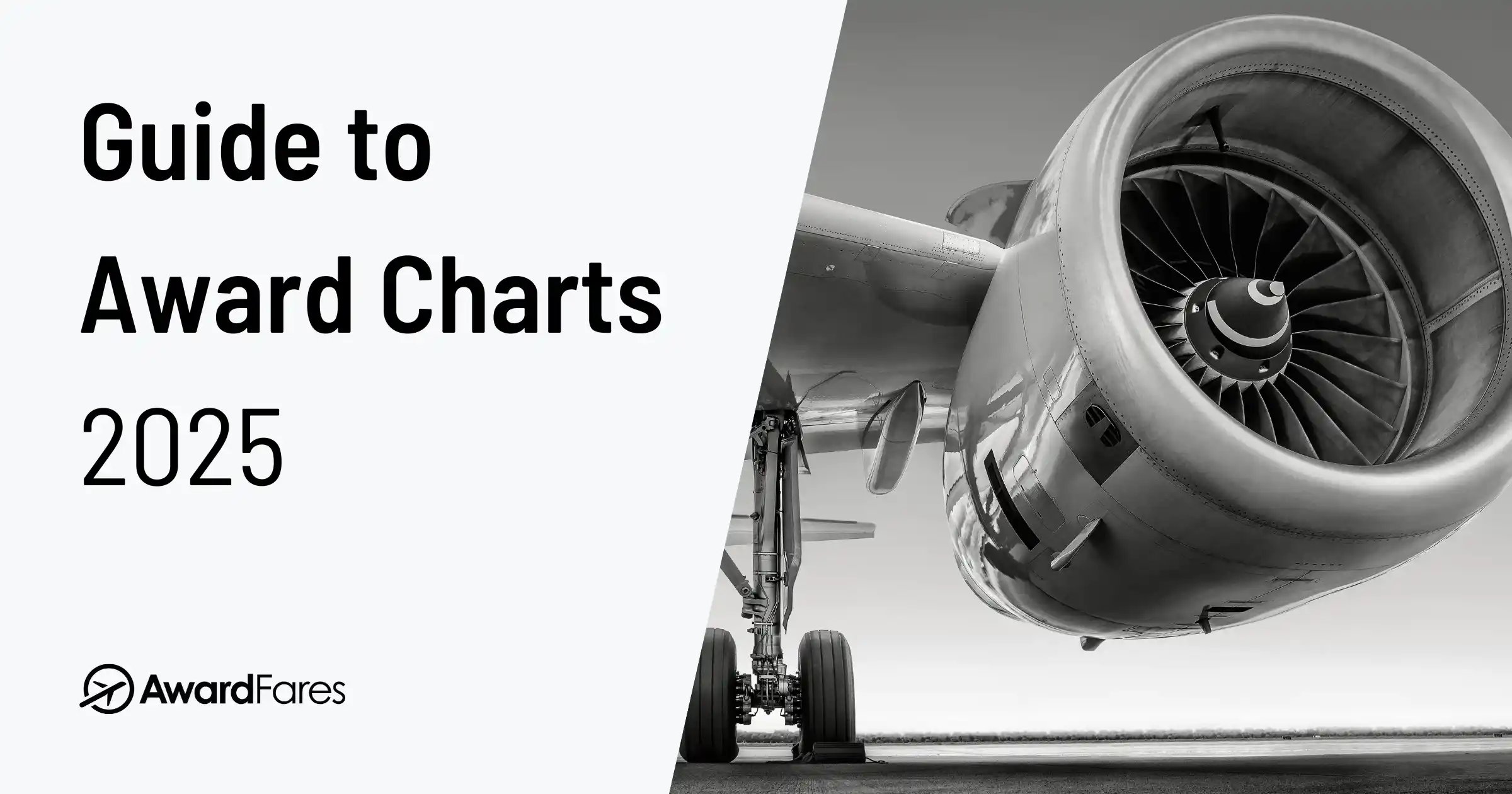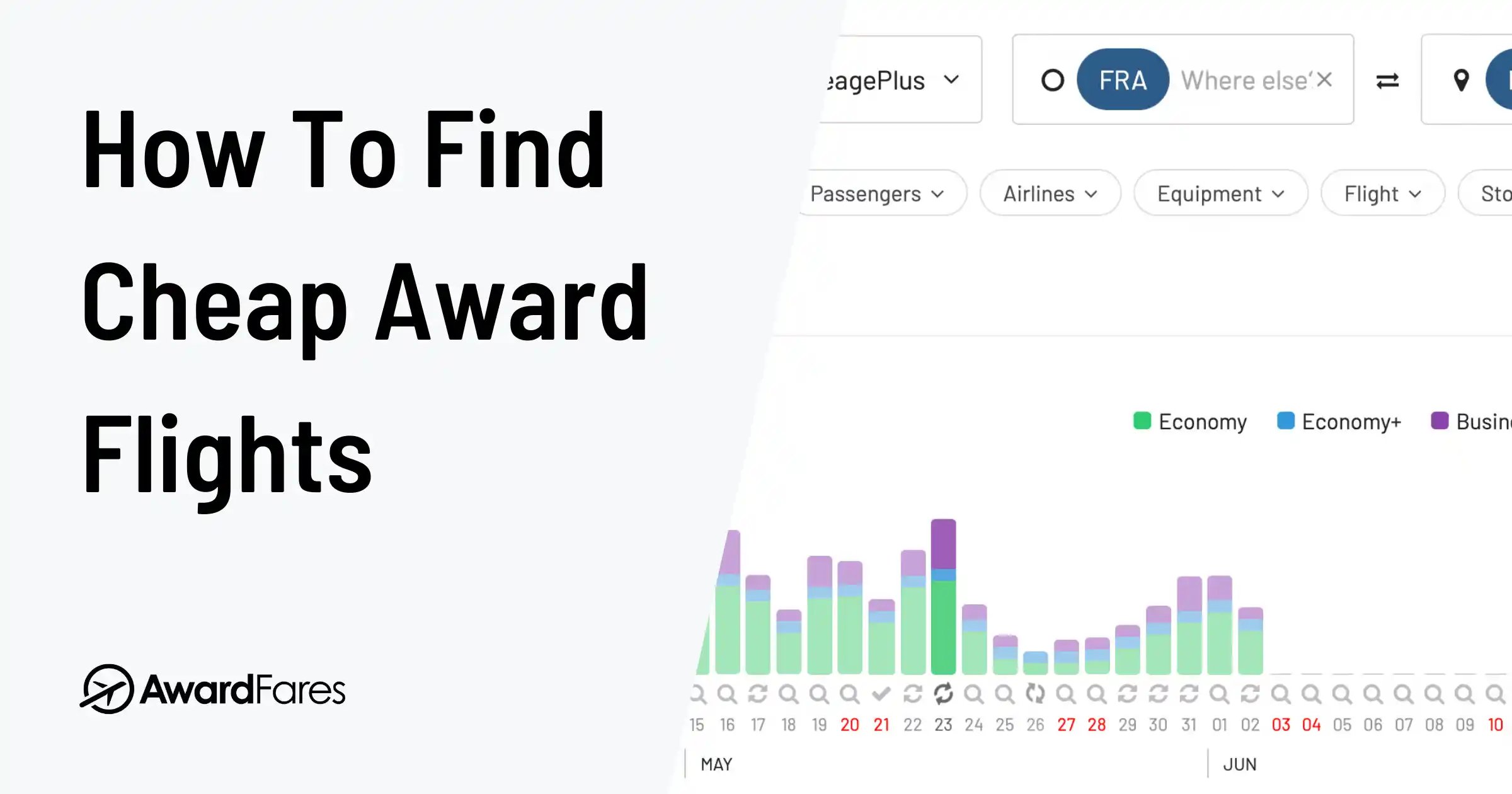For frequent travelers, airline loyalty programs offer a myriad of benefits that not only enhance the travel experience but make it more cost-effective. Since American Airlines introduced the very first frequent flyer program in the 80s, it became clear that staying loyal to one airline could reward customers a long way.
The core of these programs is the award charts, as it is how travelers can use their hard-earned miles for free travel, hotel nights, products, or experiences. However, understanding these award charts takes a lot of work due to their complexity and variation across different airlines, and it is becoming increasingly more difficult.
In this comprehensive guide, we go through the different types of award charts in frequent flyer programs and what you can do today to leverage your miles to the maximum.
Key Takeaways
- What Award Charts Are: The rulebooks airlines use to set the mileage price for award flights, based on region, distance, or cash price.
- The Shift to Dynamic Pricing: Most major airlines (e.g., United, Delta, American) now use dynamic pricing, where award costs fluctuate with demand, making fixed-price charts rare.
- Key Chart Types: Main models include Zone-Based (fixed price between regions), Distance-Based (price by miles flown), and Dynamic. Many programs now use a Hybrid approach.
- Why Airlines Are Changing: To maximize revenue, eliminate predictable “sweet spots,” and better manage seat inventory.
- How to Find Value: In this new era, using powerful tools like AwardFares is essential to compare programs, find hidden deals, and navigate unpredictable pricing.
In This Guide
Frequent Flyer Programs, Award Chart Types, and Earning Models
The Unmistakable Trend
Notice a pattern in the tables below? Dynamic and Hybrid models are taking over. Fixed charts, especially for an airline’s own flights, are becoming a rarity. The most predictable value is now often found on partner awards within programs that still use fixed charts for them.
Star Alliance
| Frequent Flyer Program | Airlines | Award Chart Type | Earning Model | Last Update |
|---|---|---|---|---|
| Aeroplan | Air Canada | Hybrid (Dynamic for AC and some partners) | Miles-Flown Based | March 2025 (Read here) |
| MileagePlus | United Airlines | Dynamic Pricing | Spend-Based | October 2024 (Read here) |
| Miles & More | Lufthansa, Austrian, SWISS, Brussels Airlines, Croatia Airlines | Hybrid (Dynamic for LH Group, Zone-Based for others) | Miles-Flown Based | February 2025 (Read here) |
| Miles&Smiles | Turkish Airlines | Dynamic Pricing | Miles-Flown Based | March 2023 |
| KrisFlyer | Singapore Airlines | Hybrid (Dynamic for SQ, Zone-Based for partners) | Miles-Flown Based | July 2023 |
| ANA Mileage Club | ANA | Distance-Based | Miles-Flown Based | January 2023 |
| Royal Orchid Plus | Thai Airways | Zone-Based | Miles-Flown Based | February 2023 |
| Asiana Club | Asiana Airlines | Distance-Based | Miles-Flown Based | April 2023 |
| PhoenixMiles | Air China, Shenzhen Airlines | Hybrid (Zone-Based for CA, Dynamic for partners) | Miles-Flown Based | August 2023 |
| Flying Returns | Air India | Zone-Based | Miles-Flown Based | September 2023 |
| Airpoints | Air New Zealand | Dynamic Pricing | Spend-Based | June 2023 |
| LifeMiles | Avianca | Hybrid (Fixed for partners, Dynamic for AV) | Miles-Flown Based | May 2023 |
| ConnectMiles | Copa Airlines | Zone-Based | Miles-Flown Based | January 2023 |
| EgyptAir Plus | EgyptAir | Zone-Based | Miles-Flown Based | 2022 (No recent update) |
| ShebaMiles | Ethiopian Airlines | Zone-Based | Miles-Flown Based | November 2023 |
| Infinity MileageLands | EVA Air | Region-Based | Miles-Flown Based | July 2023 |
| LOT Miles | LOT Polish Airlines | Zone-Based | Miles-Flown Based | March 2023 |
| Voyager | South African Airways | Zone-Based | Miles-Flown Based | 2021 (No recent update) |
| Miles&Go | TAP Air Portugal | Dynamic Pricing | Spend-Based | April 2023 |
| Miles+Bonus | Aegean Airlines | Zone-Based | Miles-Flown Based | August 2023 |
oneworld
| Frequent Flyer Program | Airlines | Award Chart Type | Earning Model | Last Update |
|---|---|---|---|---|
| AAdvantage | American Airlines | Dynamic Pricing | Spend-Based | March 2025 (Read here) |
| Mileage Plan | Alaska Airlines, Hawaiian Airlines | Distance-Based | Hybrid (Miles + Revenue) | October 2024 (Read here) |
| British Airways Club | British Airways | Distance-Based (Avios) | Spend-Based | January 2025 (Read here) |
| Iberia Plus | Iberia | Distance-Based (Avios) | Spend-Based | February 2025 (Read here) |
| Qantas Frequent Flyer | Qantas | Hybrid (Fixed until Aug 2025, Dynamic from Aug 2025) | Miles-Flown Based | January 2025 (Read here) |
| Asia Miles | Cathay Pacific | Zone-Based | Miles-Flown Based | March 2023 |
| JAL Mileage Bank | Japan Airlines | Distance-Based | Hybrid (Miles + Revenue) | June 2023 |
| Privilege Club | Qatar Airways | Dynamic Pricing (Avios) | Miles-Flown Based | July 2023 |
| Finnair Plus | Finnair | Dynamic Pricing | Spend-Based | January 2023 |
| Enrich | Malaysia Airlines | Zone-Based | Miles-Flown Based | April 2022 |
| Royal Club | Royal Jordanian | Zone-Based | Miles-Flown Based | 2021 (No recent update) |
| Tabua Club | Fiji Airways | Zone-Based | Miles-Flown Based | September 2023 |
| FlySmiles | SriLankan Airlines | Zone-Based | Miles-Flown Based | March 2023 |
| Sinbad | Oman Air | Region-Based | Miles-Flown Based | 2022 (No recent update) |
SkyTeam
| Frequent Flyer Program | Airlines | Award Chart Type | Earning Model | Last Update |
|---|---|---|---|---|
| SAS EuroBonus | Scandinavian Airlines (SAS) | Zone-Based | Spend-Based | January 2025 (Read here) |
| SkyMiles | Delta Air Lines | Dynamic Pricing | Spend-Based | September 2023 |
| Flying Blue | Air France, KLM, Kenya Airways, Transavia, TAROM | Dynamic Pricing | Miles-Flown Based | October 2024 |
| Aeroméxico Rewards | Aeroméxico | Hybrid (Dynamic for AM, Distance-Based for partners) | Miles-Flown Based | July 2023 |
| Flying Club | Virgin Atlantic | Distance-Based | Hybrid (Miles + Revenue) | October 2024 (Read here) |
| SKYPASS | Korean Air | Distance-Based | Hybrid (Miles + Revenue) | August 2023 |
| Volare | ITA Airways | Distance-Based | Spend-Based | January 2023 |
| Dynasty Flyer | China Airlines | Zone-Based | Miles-Flown Based | March 2023 |
| GarudaMiles | Garuda Indonesia | Distance-Based | Miles-Flown Based | 2022 (No recent update) |
| Lotusmiles | Vietnam Airlines | Distance-Based | Miles-Flown Based | February 2023 |
| Alfursan | Saudia | Zone-Based | Miles-Flown Based | April 2023 |
| SUMA | Air Europa | Dynamic Pricing | Spend-Based | October 2023 |
| Eastern Miles | China Eastern | Zone-Based | Miles-Flown Based | September 2023 |
| Egret Club | XiamenAir | Distance-Based | Miles-Flown Based | June 2023 |
| Cedar Miles | Middle East Airlines | Distance-Based | Miles-Flown Based | December 2022 |
| Aerolíneas Plus | Aerolíneas Argentinas | Distance-Based | Miles-Flown Based | August 2023 |
Other Airlines
| Frequent Flyer Program | Airlines | Award Chart Type | Earning Model | Last Update |
|---|---|---|---|---|
| Etihad Guest | Etihad Airways | Dynamic Pricing | Hybrid (Miles + Tier Credits) | November 2023 |
| Velocity Frequent Flyer | Virgin Australia | Hybrid (Dynamic for VA, Zone-Based for partners) | Spend-Based | October 2024 (Read here) |
| Smiles (Brazil) | GOL Linhas Aéreas | Dynamic Pricing | Distance-Based | March 2023 |
| Smiles (Argentina) | GOL Linhas Aéreas | Dynamic Pricing | Distance-Based | March 2023 |
| Fidelidade | Azul Brazilian Airlines | Dynamic Pricing | Spend-Based | August 2023 |
| TrueBlue | JetBlue | Dynamic Pricing | Spend-Based | October 2023 |
| Emirates Skywards | Emirates | Dynamic Pricing | Spend-Based | September 2023 |
Caution: Outdated Information
Smaller programs like EgyptAir Plus or Royal Jordanian often don’t publicize changes. Always double-check award costs directly with the airline before transferring points, as their charts can be outdated or unpublished.
What are Award Charts?
Award charts are basically tables that outline how many miles or points you’ll need to redeem for a free flight (an award flight) in a frequent flyer program. They form the basis of any airline loyalty program, detailing the cost in miles from one region to another, often further divided by cabin class (economy, business, or first).
Different Types of Award Charts
Award charts can be of different types, depending on what criteria they use to determine the price (in miles or points) of the award tickets. Here are the most common ones.
Zone-Based Award Charts
Zone-based award charts are The most common type you’ll encounter. These charts categorize countries into different zones or regions, with a fixed amount of miles needed to travel from one zone to another. For instance, before 2022, American Airlines AAdvantage used a zone-based award chart where North America to Europe in business class is a fixed 57,500 miles one-way, regardless of whether you’re flying from New York to London or Los Angeles to Istanbul.
Pro Tip: Maximize Your Zones
The sweet spot in zone-based charts is flying the longest possible route within a given zone pairing. For example, flying from the US West Coast to Eastern Europe might cost the same number of miles as flying from New York to London, offering incredible value for the distance covered.
Distance-Based Award Charts
As the name suggests, distance-based award charts calculate the miles needed based on the actual flight distance. Airlines such as British Airways and Cathay Pacific use distance-based charts. Short-haul flights can offer exceptional value, as the miles required can be significantly less than in zone-based systems.
Warning: The Connection Trap
Distance-based charts can be a trap for itineraries with connections. Since each flight segment’s distance is often added up, a multi-stop journey can become significantly more expensive than a non-stop flight or a comparable zone-based award.
Revenue-Based Award Charts
In revenue-based award charts, the miles needed for an award flight are directly tied to the ticket cost. Airlines such as Southwest Airlines and JetBlue follow this model. The higher the ticket price, the more miles you’ll need to redeem an award flight.
This type of award chart offers simplicity and transparency since you know precisely how your miles equate to dollar value. However, they generally provide less opportunity for “sweet spots” or outsized value than zone- and distance-based charts.
Region-Based Award Charts
Similar to zone-based charts, region-based award charts group countries into regions but with one significant difference — they also take into account the region you’re flying from. This means the mileage cost varies not just based on your destination but also your departure point.
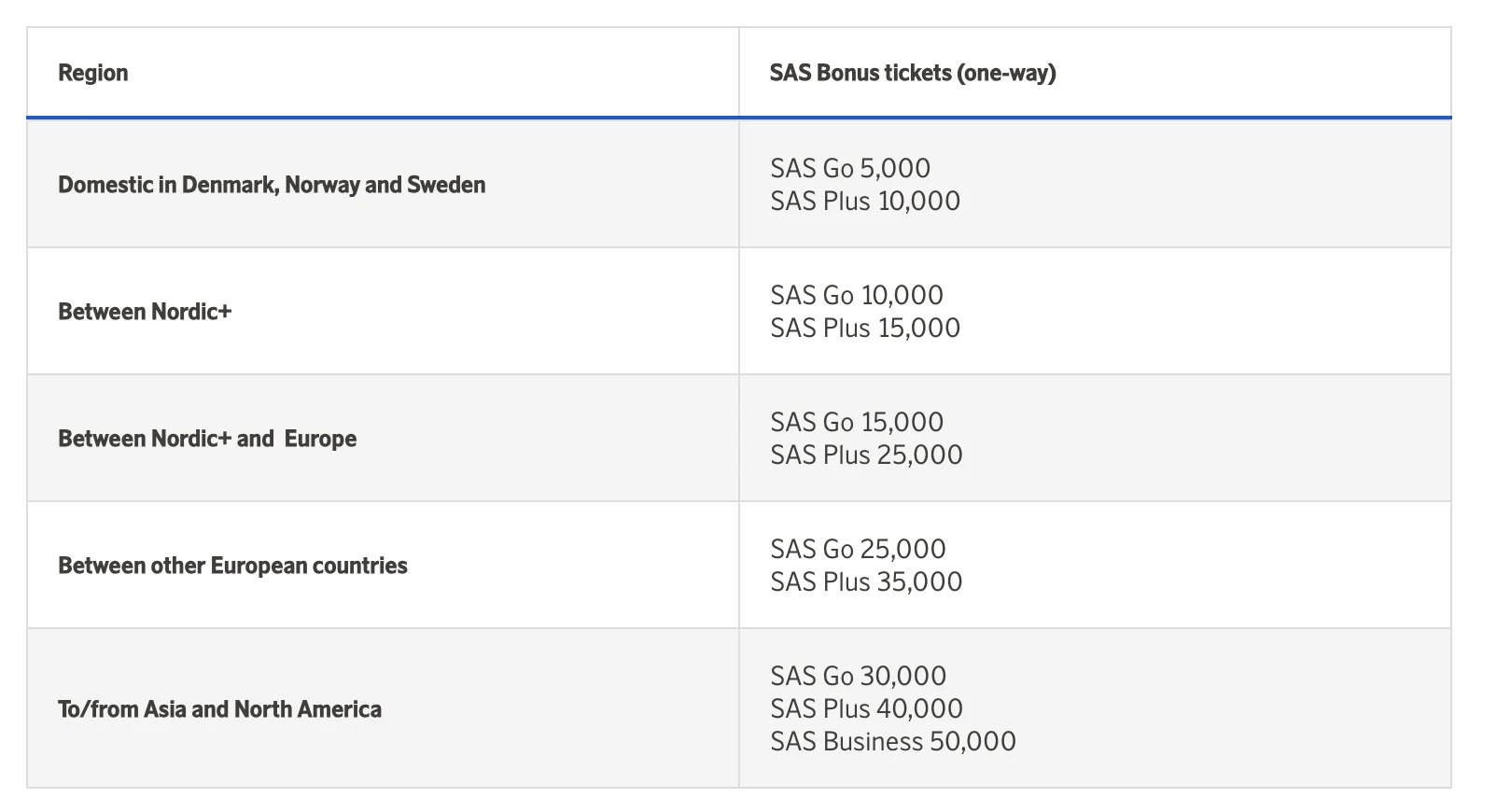
Hybrid Award Charts
Hybrid award charts combine elements from multiple types of award charts. For instance, Delta Air Lines has an undisclosed award chart that appears to mix zone, distance, and revenue elements. Although this lack of transparency can be frustrating, savvy travelers who spend time understanding the program’s nuances can still find good redemption opportunities.
Dynamic Pricing
Dynamic pricing strays away from the concept of a fixed chart, instead adjusting the mileage cost based on demand and other factors. It’s a model that more airlines are moving towards, such as American Airlines AAdvantage and United MileagePlus.
The Peril of Dynamic Pricing
While dynamic pricing can sometimes offer cheap awards during the low season, it more often leads to astronomical costs during peak travel times. Your 50,000 miles might be worth a business class seat one day and barely cover an economy ticket the next. Predictability is lost, which is the biggest drawback for award travelers.
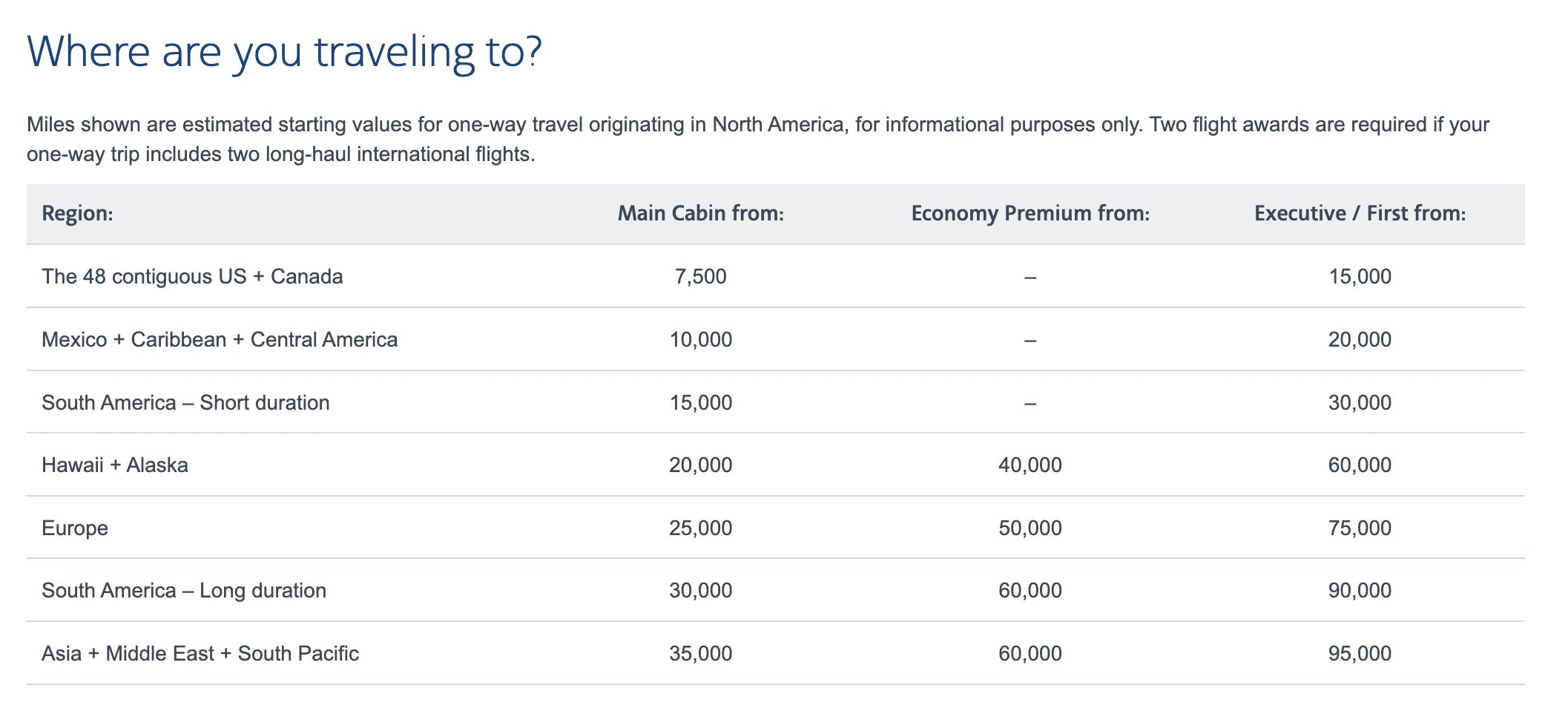
Summary of Award Chart Types
| Type of Award Chart | Description | Pros | Cons |
|---|---|---|---|
| Distance-based | Price is based on the distance flown. | Great value on short, direct flights. | Can be very expensive for long-haul or connecting flights. |
| Region-based | Price is based on the region you are flying to and from. | More nuanced pricing than zone-based charts. | Can be complex with many origin/destination pairs. |
| Revenue-based | Price is tied to the cash cost of the ticket. | Simple and transparent. | Eliminates the chance for outsized value or “sweet spots”. |
| Hybrid | Combines multiple chart types. | Can offer diverse redemption opportunities. | Lack of transparency and potential for complexity. |
| Dynamic pricing | Price fluctuates with demand, time of booking, etc. | More award seats are theoretically available. | Unpredictable costs, can be extremely expensive. |
Understanding Your Program’s Award Chart
Regardless of the type of award chart your frequent flyer program uses, understanding it is crucial to maximize your miles’ value. Research the sweet spots, keep up to date with changes (airlines often devalue their charts), and use tools like AwardFares to help plan redemptions.
What is a good redemption?
A good redemption is one that gives you the most value for your miles. This means finding a flight that you would have paid a lot of money for in cash, but can instead redeem for a relatively low number of miles.
Here are a few things to keep in mind when looking for a good redemption:
- The cost of the flight in cash: The higher the cash price, the better your potential redemption value.
- The number of miles required: The fewer miles required for that expensive flight, the better.
- The availability of award seats: Finding a seat is the first hurdle. Premium cabin seats on popular routes are toughest to find.
- Your loyalty status: Elite status can unlock better availability or lower pricing on some airlines.
Stay tuned to our posts, we regularly publish guides and articles on how to find and book the best sweet spots on each program.
Dynamic Award Pricing: Which Airlines Have Adopted It in 2025?
As of 2025, many major airlines across the three global alliances have adopted dynamic pricing, particularly for their own flights. In Star Alliance, programs like United MileagePlus, Turkish Miles&Smiles, and Air New Zealand Airpoints are fully dynamic. Within oneworld, American AAdvantage, Qatar Airways Privilege Club, and Finnair Plus have gone dynamic, with Qantas following suit. In SkyTeam, dynamic pricing is standard for Delta SkyMiles and Flying Blue (Air France/KLM). This widespread shift reflects airlines’ focus on aligning award costs with real-time demand, offering more flexibility but less predictable rates.
Why are Airlines Shifting to Dynamic Pricing Award Charts?
The move away from predictable, fixed award charts to dynamic models is driven by several key business factors.
1. Technology and Data Analysis
Airlines now have powerful systems that analyze demand, seasonality, and competitor pricing in real-time, allowing them to adjust award prices on the fly to maximize profit.
2. Revenue Management
Dynamic pricing allows airlines to align award costs more closely with a seat’s actual cash value. This prevents them from “losing” revenue by giving away a high-value last-minute business class seat for a low, fixed number of miles.
3. Influencing Customer Behavior
By lowering award costs on less popular routes or during off-peak periods, airlines can stimulate demand and fill empty planes. Conversely, they can price awards sky-high on popular flights to preserve seats for cash-paying customers.
4. Eliminating Sweet Spots
Traditional award charts had well-known “sweet spots” that savvy travelers exploited for massive value. Dynamic pricing makes these loopholes nearly impossible to find, protecting the airline’s bottom line.
5. The Illusion of Simplicity
On the surface, tying award cost to ticket price seems simpler. However, the lack of a fixed chart makes it much harder for members to plan and know how many miles they need to save for a specific goal.
It's All About Revenue
At its core, the shift to dynamic pricing is about one thing: maximizing revenue. By tying award costs to the cash price of a seat, airlines protect their bottom line and reduce the “cost” of loyalty programs.
Unlock Award Chart Sweet Spots with AwardFares
Find the best ways to redeem your miles with AwardFares—the fastest and most powerful search engine for award flights. Search availability across 14 frequent flyer programs, including United MileagePlus, Air Canada Aeroplan, Flying Blue, AAdvantage, and more. Compare routes and redemption options from over 50 airlines within Star Alliance, oneworld, and SkyTeam—all in seconds.
Never miss out on premium cabin seats with real-time award alerts, notifying you the moment award space opens up. Get detailed flight information, including seat maps for Business and First Class cabins—so you can pick flights with the best seats.
AwardFares’ modern, mobile-friendly interface makes comparing flights quick and easy. Plus, with historical award availability data, spot patterns that help you book at the right time. Whether you’re looking for a business class sweet spot to Asia or a last-minute first-class deal to Europe, AwardFares gives you the tools to find it—faster, smarter, and with fewer miles.
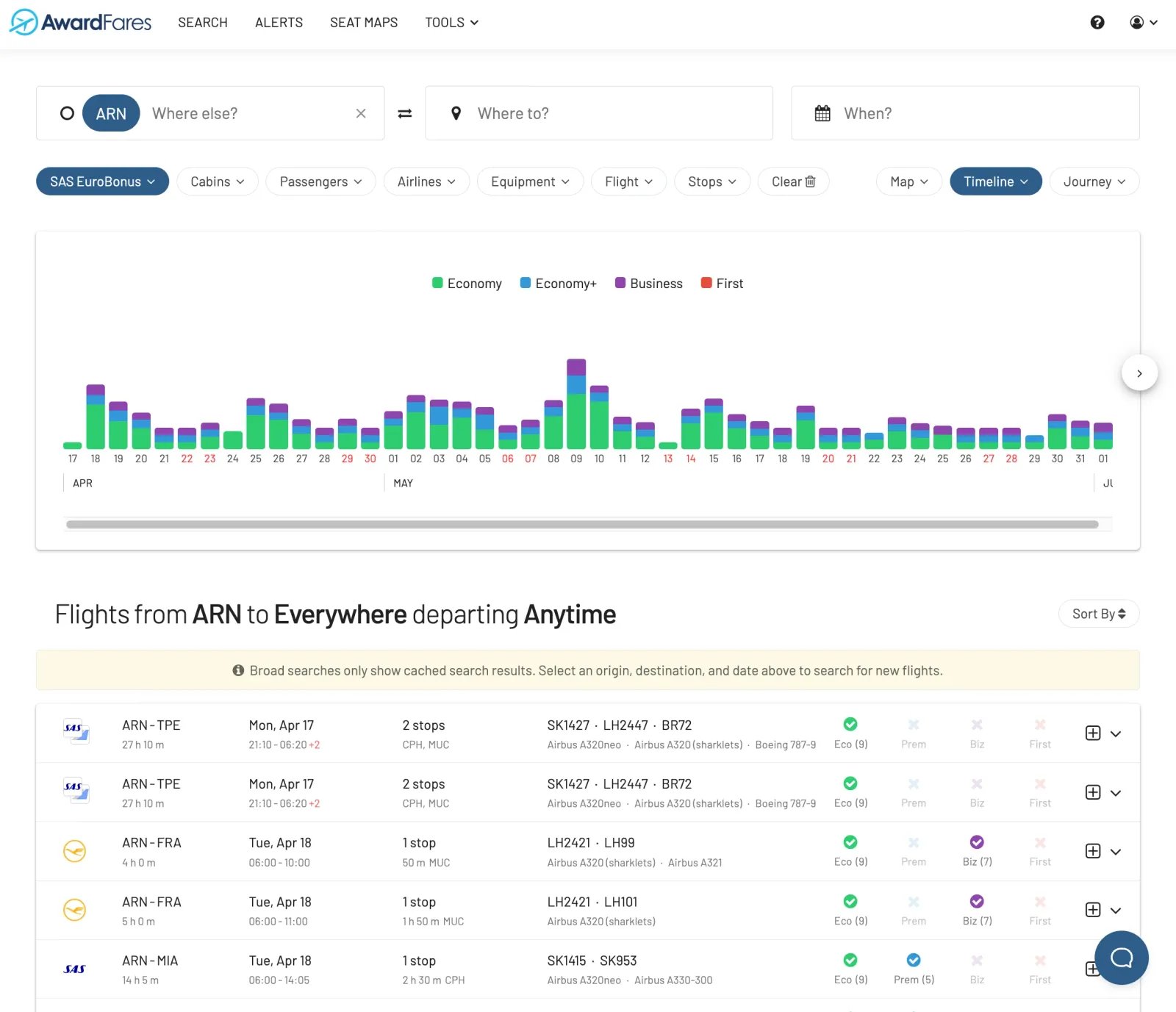
How to Beat Any Award Chart with AwardFares
- Use powerful filters to narrow your search by airline, cabin, number of stops, and more.
- Compare programs side-by-side to see which offers the best rate for the same flight.
- Set up award alerts to get notified the moment seats open on your desired route.
- Be flexible with your dates. Use the calendar view to spot the cheapest days to fly at a glance.
- Check partner airline availability. Find hidden gems by redeeming miles from one program for flights on another.
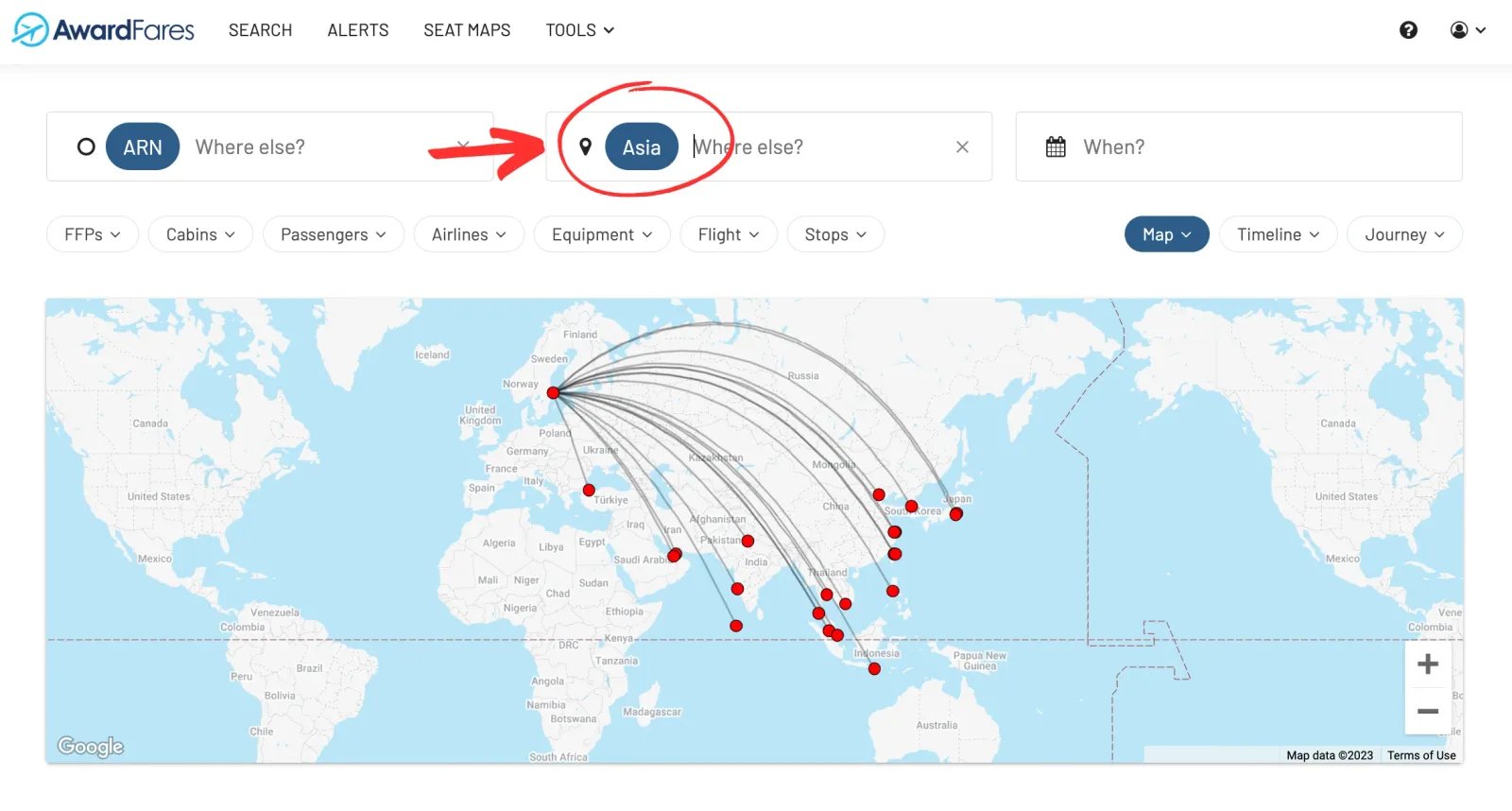
Frequently Asked Questions
Your Award Chart Questions Answered
What is an award chart?
An award chart is a table or system an airline uses to show how many miles or points are required to book an award flight. The cost can be based on geographic zones, flight distance, or fluctuate with demand (dynamic pricing).
Why are so many airlines switching to dynamic pricing?
Airlines are moving to dynamic pricing to better align award costs with the cash price of a ticket, demand, and seasonality. This helps them maximize revenue, control seat inventory, and eliminate predictable “sweet spots” that were common with fixed charts.
What is the difference between a zone-based and a distance-based award chart?
A zone-based chart has a fixed mileage price for travel between two large regions (e.g., 60,000 miles from North America to Europe), regardless of the exact cities. A distance-based chart calculates the price based on the actual distance flown, making short flights cheaper and very long flights more expensive.
How can I find good value if my airline uses dynamic pricing?
Finding value requires flexibility. The best strategies are to:
-
Search for travel during off-peak dates or seasons.
-
Book very far in advance or at the last minute.
-
Use a powerful award search tool like AwardFares to quickly compare prices across many dates and even different loyalty programs.
Do any airlines still use fixed award charts?
Yes, but they are less common. Many programs now use a hybrid model: dynamic pricing for their own flights but a fixed, predictable award chart for flights on partner airlines. This is where some of the best value can still be found.
Want More Award Travel Intel?
Imagine flying to Paris in a lie-flat business class seat for the price of an economy ticket. On average, AwardFares premium users get 3x-7x more value from their points, regularly booking $5,000+ flights at a fraction of the cost.
AwardFares is the easiest way to find the cheapest and most convenient award flights across multiple frequent flyer programs. It takes just seconds and a few clicks to get started. You can create an account and try it for free here.
For access to even more powerful features like unlimited daily searches, alerts, seat maps, and flight schedules, explore our Gold and Diamond membership tiers here.
Read More
Our guides have all the information you need to be a pro travel hacker and explore the world on points. Here are some related posts you might enjoy:
 Aeromexico Rewards
Aeromexico Rewards Air Canada Aeroplan
Air Canada Aeroplan
 Air France / KLM Flying Blue
Air France / KLM Flying Blue Alaska MileagePlan
Alaska MileagePlan American Airlines AAdvantage
American Airlines AAdvantage Azul Fidelidade
Azul Fidelidade Delta SkyMiles
Delta SkyMiles Etihad Guest
Etihad Guest GOL Smiles
GOL Smiles Jetblue TrueBlue
Jetblue TrueBlue SAS EuroBonus
SAS EuroBonus Turkish Miles&Smiles
Turkish Miles&Smiles United MileagePlus
United MileagePlus Virgin Atlantic Flying Club
Virgin Atlantic Flying Club Virgin Australia Velocity
Virgin Australia Velocity